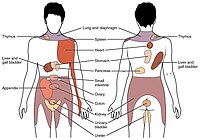
Photo from wikipedia
Previous studies have shown poor health-related outcomes among patients with spinal sagittal malalignment of the thoracolumbar or spinopelvic region, and less interest has been paid to the relationship between cervical… Click to show full abstract
Previous studies have shown poor health-related outcomes among patients with spinal sagittal malalignment of the thoracolumbar or spinopelvic region, and less interest has been paid to the relationship between cervical sagittal balance and functional outcome of the patients. This study aims to compare the cervical sagittal parameters between patients with non-specific neck pain and asymptomatic controls. Twenty-five patients (21 females/4 males) with non-specific neck pain and 25 age-, sex- and BMI-matched controls (18 females/7 males) participated in the study. Using a standard lateral cervical radiography, the Cobb angle between occiput–C2, C1–C2, C1–C7 and C2–C7 as well as the thoracic inlet angle (TIA) and C7 and T1 slope angles was measured. Also the spine cranial angle (SCA) and the C2–SVA (sacral vertical axis) and C1–SVA were measured. The primary outcome measure of the study was comparison of the sagittal balance variables between the patients and the healthy controls. Secondary outcome measures were correlation between pain intensity of the patients in neck pain group and their demographic and radiographic findings. Data analysis was performed using independent sample T test and Pearson’s correlation for primary and secondary outcome measurements, respectively. There was no difference in cervical lordosis curvature (measured by C2–C7 and C1–C7 lordosis angle) between patients with non-specific NP and healthy controls (P value = 0.45 and 0.37, respectively). We found that T1 slope angle was significantly (P value = 0.02) lower in patients with neck pain. Our findings showed that the slope of the upper endplate of T1 vertebrae body (T1 slope) is significantly lower among patients with non-specific neck pain compared to controls. A compensatory mechanism to bring the center of head gravity back to the spinal axis might be the possible explanation for this difference. These slides can be retrieved under Electronic Supplementary Material.
Journal Title: European Spine Journal
Year Published: 2019
Link to full text (if available)
Share on Social Media: Sign Up to like & get
recommendations!